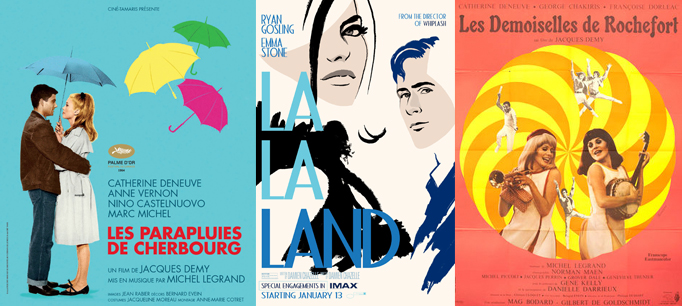Now that La La Land is in wide release word of mouth from regular moviegoers (rather than critics) keeps expanding. As expected with Best Picture frontrunners, not all of it is kind. This unique and ravishing film has begun to suffer from the inevitable backlash. Some of my musical theater friends are balking that neither star is a great singer, the songs aren’t sophisticated, and it doesn’t honor Hollywood musicals in the way they’d expected.

To harp on these issues misses the point of what director Damien Chazelle has created. It's true that neither Emma Stone nor Ryan Gosling have Broadway-caliber singing voices, and it’s also true that future composers of musical theater are likelier to study Sondheim than Justin Hurwitz. But Chazelle isn’t making a Broadway show, he’s crafting a wholly-original tone for a film, stealing bits and pieces from a wide variety of sources, and doesn’t seem interested in making a purely traditional Hollywood musical.
Chazelle has spoken in interviews about how the single greatest influence on La La Land were the two musical films of French director Jacques Demy: The Umbrellas of Cherbourg, and The Young Girls of Rochefort...
So there’s no time like the present to dig back into the 1960s and look at these two films and their similarities to one of this year’s leading Best Picture contenders.

If you want to witness mediocre singing and dancing in a movie musical, one need look no further than these two French classics. There’s not a powerful voice among the cast of either film, yet neither is hurt by this fact. The singing sometimes even has an oddly canned effect, where you can’t quite make out the lyrics. La La Land’s opening number “Another Day of Sun” has this same quality: it feels pre-recorded on purpose, to put you in the frame of mind of watching something artificial. That number opens on a highway, much akin to Rochefort’s opening number on a sequence of roads (neither number features the film’s respective leads, and both feature people headed to work). Cherbourg commences with singing mechanics at an auto garage. All three films want to thrust the viewer into a stylized reality immediately.
Tonally, Chazelle borrows the candy-cane sunniness of Rochefort and the bittersweet sadness of Cherbourg at his discretion. Demy’s films were his own homage to Hollywood musicals, but filtered through a French sensibility, and manifested with somewhat of a commentary/frame around them. Hollywood musicals, as a product of their time, benefitted from the natural optimism and true desire for escapism that most Americans felt, and that ran through most of the films produced during their heyday. The French in general do not inherently share these attributes, so Rochefort and Cherbourg have their own self-aware, elevated energy. The first number with the mechanics in Cherbourg includes a debate about which is better, theater or cinema, with one character complaining, while singing, that he hates all that singing in the theater. Both films feature simple plots about lovers and dreamers, meant to appeal to the viewer’s inner romantic. The success of La La Land rises and falls on Chazelle’s ability to invoke that same suppressed idealism.


Visually, La La Land takes many cues from both Demy films. Emma’s song with her roommates has the girls costumed in primary-colored jewel tone dresses that recall the continuously-mirrored costuming of real-life sisters Catherine Deneuve and Francoise Dorleac in Rochefort. While one could argue that bright colors aren’t exactly revolutionary for a musical, once again there is a purposefully-heightened, exaggerated use of that color. There are numerous examples in all three films of sets that include oversaturated primaries and soft pastels utilized specifically to sustain the energy and style of the pictures.
La La Land also utilizes the power of practical locations in a way similar to the Demy movies. Many Hollywood movies were shot entirely on sets, with no practicals. Umbrella’s two most stunning sequences, the main theme song sung at the Cherbourg train station and the finale at the overlit gas station, use real locations at the film’s most “human” and powerful moments, when we need to register genuine sadness for the character’s actual loss. On a lighter note, Rochefort has its characters singing and dancing on the actual streets of its eponymous town throughout. Chazelle takes bits and pieces of this as inspiration: his sequence shot at Griffith Observatory is the romantic high of the picture, and he includes many moments when Emma Stone does a small dance bit on the street, or exiting the incline, that sustains the tone of the piece when there’s no actual singing or dancing.


It’s an oversimplification to say that American moviegoing audiences now have a cynical sensibility that French audiences already had in the 1960s, but it’s not far off either. Contemporary audiences do look for a language that allows them to “accept” characters singing and dancing, and Chazelle took that charge seriously. The beauty of La La Land is that he takes from the French Demy classics, but he also takes liberally from the Hollywood classics. He then goes further, smartly selecting what worked beautifully from both, throwing them into a blender to come up with a sensibility all his own. Chazelle brings the delicacy you need to believe in a love story about dreamers, but he has the maturity to knock a blow to what’s lost in their journey.